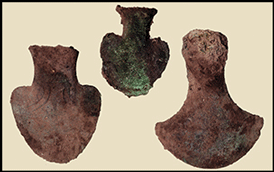Crossref Citations
This article has been cited by the following publications. This list is generated based on data provided by
Crossref.
d'Alpoim Guedes, Jade
Hanson, Sydney
Lertcharnrit, Thanik
Weiss, Andrew D.
Pigott, Vincent C.
Higham, Charles F.W.
Higham, Thomas F.G.
and
Weber, Steven A.
2020.
Three thousand years of farming strategies in central Thailand.
Antiquity,
Vol. 94,
Issue. 376,
p.
966.
Le Meur, Clémence
Cadet, Mélissa
Doan, Nguyen Van
Trien, Dinh Ngoc
Cloquet, Christophe
Dillmann, Philippe
Thote, Alain
and
Pryce, T.O.
2021.
Typo-technological, elemental and lead isotopic characterization and interpretation of Đông Sơn miniature drums.
Journal of Archaeological Science: Reports,
Vol. 38,
Issue. ,
p.
103017.
Higham, Charles F.W.
2021.
The later prehistory of Southeast Asia and southern China: the impact of exchange, farming and metallurgy.
Asian Archaeology,
Vol. 4,
Issue. 2,
p.
63.
Liu, Ruiliang
Pollard, A. Mark
Lv, Feiya
Huan, Limin
Zhang, Shanjia
and
Ma, Minmin
2021.
Two Sides of the Same Coin: A Combination of Archaeometallurgy and Environmental Archaeology to Re-Examine the Hypothesis of Yunnan as the Source of Highly Radiogenic Lead in Early Dynastic China.
Frontiers in Earth Science,
Vol. 9,
Issue. ,
Higham, C. F. W.
and
Cawte, H.
2021.
Bronze Metallurgy in Southeast Asia with Particular Reference to Northeast Thailand.
Journal of World Prehistory,
Vol. 34,
Issue. 1,
p.
1.
Cadet, Mélissa
Tereygeol, Florian
Sayavongkhamdy, Thongsa
Souksavatdy, Viengkeo
Luangkhoth, Thonglith
Chang, Nigel
Dillmann, Philippe
and
Pryce, T.O
2021.
Late prehistoric copper smelting in the Lao PDR: Experimental reconstruction based on the Vilabouly Complex evidence.
Journal of Archaeological Science: Reports,
Vol. 37,
Issue. ,
p.
102932.
Cadet, Mélissa
Pryce, T. O.
Dillmann, Philippe
Sayavongkhamdy, Thongsa
Souksavatdy, Viengkeo
Luangkhoth, Thonglith
and
Chang, Nigel
2022.
Technological reconstruction of the late prehistoric primary copper production of the Vilabouly Complex (central Laos).
Archaeological and Anthropological Sciences,
Vol. 14,
Issue. 8,
Pryce, T. O.
Cadet, Mélissa
Allard, Francis
Kim, Nam C.
Hiep, Trinh Hoang
Dung, Lam Thi My
Lam, Wengcheong
and
Foy, Eddy
2022.
Copper-base metal supply during the northern Vietnamese Bronze and Iron Ages: metallographic, elemental, and lead isotope data from Dai Trach, Thành Dên, Gò Mun, and Xuân Lâp.
Archaeological and Anthropological Sciences,
Vol. 14,
Issue. 1,
Lawson, Lynda
and
Chowdhury, Arnab Roy
2022.
Women in Thailand’s gem and jewellery industry and the Sustainable Development Goals (SDGs): Empowerment or continued inequity?.
Environmental Science & Policy,
Vol. 136,
Issue. ,
p.
675.
Pryce, T.O.
Lam, Wengcheong
Cadet, Mélissa
Jiang, Zhilong
Yang, Wei
and
Yao, Alice
2022.
A late 2nd/early 1st millennium BC interaction arc between Mainland Southeast Asia and Southwest China: Archaeometallurgical data from Hebosuo and Shangxihe, Yunnan.
Journal of Archaeological Science,
Vol. 143,
Issue. ,
p.
105612.
Carter, Alison Kyra
2023.
Building from the Ground Up: The Archaeology of Residential Spaces and Communities in Southeast Asia.
Journal of Archaeological Research,
Vol. 31,
Issue. 1,
p.
1.
Lu, Yongxiu
Gao, Feng
Wang, Yiren
Ma, Minmin
Zhou, Aifeng
Liu, Ruiliang
Kikuchi, Hiroki
Ren, Lele
Shao, Qingfeng
Chen, Lin
Xu, Yongxiang
Li, Haoran
and
Dong, Guanghui
2023.
Diversification of faunal exploitation strategy and human-climate interaction in Southern China and Southeast Asia during the last deglaciation.
Quaternary Science Reviews,
Vol. 322,
Issue. ,
p.
108420.
Ma, Minmin
Lu, Yongxiu
Dong, Guanghui
Ren, Lele
Min, Rui
Kang, Lihong
Zhu, Zhonghua
Li, Xiaorui
Li, Bo
Yang, Zhijian
Cili, Nongbu
Liu, Ruiliang
Gao, Yu
and
Chen, Fahu
2023.
Understanding the transport networks complex between South Asia, Southeast Asia and China during the late Neolithic and Bronze Age.
The Holocene,
Vol. 33,
Issue. 2,
p.
147.
Higham, Charles
2024.
Aggrandisers and the first copper-base metallurgy in Southeast Asia.
Antiquity,
Vol. 98,
Issue. 398,
p.
433.
Pryce, T.O.
Carrignon, Simon
Cadet, Mélissa
Oo, Kay Thwe
Oo, Saw Naing
Win, Thu Thu
Aye, Arkar
Pradier, Baptiste
Bellina, Bérénice
Meur, Clémence Le
Petchey, Peter
and
Radivojević, Miljana
2024.
A Partial Prehistory of the Southwest Silk Road: Archaeometallurgical Networks along the Sub-Himalayan Corridor.
Cambridge Archaeological Journal,
Vol. 34,
Issue. 2,
p.
173.
Ma, Minmin
Lu, Minxia
Sun, Rui
Zhu, Zhonghua
Fuller, Dorian Q.
Guo, Jianxin
He, Guanglin
Yang, Xiaomin
Tan, Lingling
Lu, Yongxiu
Dong, Jiajia
Liu, Ruiliang
Yang, Jishuai
Li, Bo
Guo, Tiannan
Li, Xiaorui
Zhao, Dongyue
Zhang, Ying
Wang, Chuan-Chao
and
Dong, Guanghui
2024.
Forager-farmer transition at the crossroads of East and Southeast Asia 4900 years ago.
Science Bulletin,
Vol. 69,
Issue. 1,
p.
103.
Fu, Jie
Li, Yuniu
Hu, Changcheng
Pan, Gaoyuan
Yang, Xiuyun
He, Qionghui
Higham, Charles
and
Li, Yingfu
2024.
Southbound transmission of metallurgy: new excavations at Jicha in the Hengduan Mountains, Yunnan.
Antiquity,
p.
1.
Pryce, T.O.
Pradier, Baptiste
Favereau, Aude
Oo, U Saw Naing
Le Meur, Clémence
Oo, Daw Kay Thwe
Aye, U Arkar
Win, Daw Thu Thu
Langowska, Kinga Alina
Hanus, Kasper
Iizuka, Yoshiyuki
Georgon, Cloé
Zhuang, Yijie
Castillo, Cristina
Fuller, Dorian
Win, Daw Hlaing Sabai
Aung, Daw Han Myo Kyi
Champion, Louis
Oo, U Myo Minh
Oo, U Min Naing
Phyo, U Zayar
Maung, U Phyo Wai
Myat, Daw Yin Min
Zaw, U Thein
Paibool, Khun Atiphat
Domethong, Khun Varis
Willis, Anna
Higham, Charles F.W.
and
Higham, Thomas F.G.
2024.
Late prehistoric and early historic chronology of Myanmar: a four-millennia sequence from Halin.
Antiquity,
Vol. 98,
Issue. 397,
p.
30.





